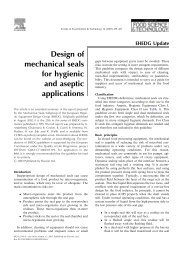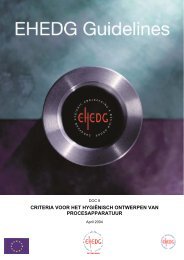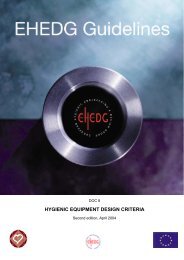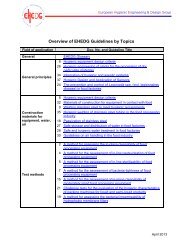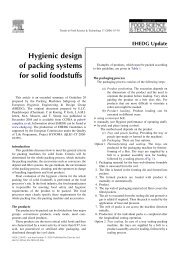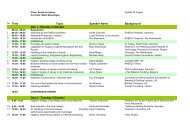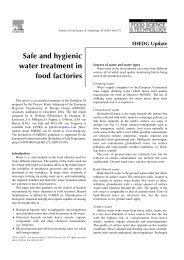Yearbook 2013/2014 - ehedg
Yearbook 2013/2014 - ehedg
Yearbook 2013/2014 - ehedg
Create successful ePaper yourself
Turn your PDF publications into a flip-book with our unique Google optimized e-Paper software.
European Hygienic Engineering & Design Group<br />
Smart hygienic solutions for the food industry<br />
Despite a stagnant economy, food and beverage companies intend to increase investments<br />
into developing new products and technologies to fuel business growth and improve revenues,<br />
according to a recent survey by the global audit company KPMG. While investing in growth,<br />
many companies remain focused on keeping costs low and efficiencies high, while at the same<br />
time emphasising compliance with food safety standards and global regulatory mandates. This<br />
article describes continuing food safety threats and the food industry’s motivation to incorporate<br />
smart hygienic solutions to overcome these challenges.<br />
Peter Uttrup, Interroll España S.A., Barcelona, Spain, phone +34 677 462 788, e-mail: p.uttrup@interroll.com<br />
and Lorenz G. Koehler, Interroll (Schweiz) AG, Sant’Antonino, Switzerland, phone: +41 91 850 25 21,<br />
e-mail: l.koehler@interroll.com, www.interroll.com<br />
Proactive risk management is the key to success in today’s<br />
economically challenging global market. For businesses<br />
in the food supply chain, this means keeping abreast of<br />
changes in the global regulatory environment, especially new<br />
food safety and hygiene standards and laws, and investing<br />
in business strategies and technologies that reduce risk to<br />
the company’s brand reputation and financial health. Some<br />
of the risks that remain high on the list of concern for the food<br />
sector are foodborne illness outbreaks, food product recalls,<br />
and quality control gaps in manufacturing facilities and other<br />
points along the supply chain.<br />
Foodborne illnesses – a constant threat<br />
A foodborne disease is any illness resulting from the<br />
consumption of food that is contaminated by pathogenic<br />
bacteria, viruses, parasites or chemical agents. Foodborne<br />
diseases pose a growing threat to public health worldwide.<br />
The most common effect of foodborne diseases takes the<br />
form of gastrointestinal symptoms, but such diseases can<br />
also lead to chronic, life-threatening conditions including<br />
neurological or immunological disorders, multi-organ<br />
failure, cancer and death. Recent global developments are<br />
increasingly challenging international health security. These<br />
developments include the growing industrialisation and trade<br />
of food production and the emergence of new or antibioticresistant<br />
pathogens.<br />
Although we do not currently have an exact figure of the global<br />
economic impact of foodborne diseases on societies, businesses<br />
and trade, the latest estimations project the costs in hundreds<br />
of billions of U.S dollars. Some of the most significant estimates<br />
include:<br />
• The U.S. Center for Disease Control and Prevention<br />
(CDC) estimates that there are roughly 48 million<br />
cases, 3,000 deaths, and 128,000 hospitalisations from<br />
foodborne pathogens each year in the United States<br />
alone. Children, the elderly, pregnant and post-partum<br />
women and individuals with compromised immune<br />
systems are at highest risk of developing complications<br />
from foodborne illness.<br />
• A new study by a former U.S. Food and Drug<br />
Administration (FDA) economist estimates the total<br />
economic impact of foodborne illness across the U.S.<br />
to be a combined $152 billion annually.<br />
• According to the CDC, in industrialised countries, the<br />
percentage of the population suffering from foodborne<br />
diseases each year has been reported to be up to 30%.<br />
• Thirty-one (31) known pathogens are responsible<br />
for 9.4 million illnesses (20% of the total), 55,961<br />
annual hospitalisations (44% of the total) and 1,351<br />
deaths (44% of the total), according to CDC data.<br />
The remaining unknown/unspecified pathogens are<br />
responsible for 38.4 million illnesses (80% of the total),<br />
71,878 annual hospitalisations (56% of the total) and<br />
1,686 deaths (56% of the total).<br />
These statistics illustrate why companies throughout the<br />
food sector continue to invest in food safety and hygiene<br />
technologies and systems that will effectively mitigate<br />
potential risks of foodborne illness associated with their<br />
products.<br />
Food recall risks<br />
Food sector companies also are increasing their vigilance<br />
in monitoring the quality and safety of foods they place on<br />
market shelves to avoid costly product recalls. A food recall<br />
occurs when there is reason to believe that a food may<br />
cause consumers to become ill. A food manufacturer or<br />
distributor initiates the recall to take foods off the market. In<br />
some situations, food recalls are requested by government<br />
agencies. A food recall can cost millions and is potentially<br />
fatal to a business. Public perception and attitudes toward a<br />
company’s products can be negatively affected by bacteriarelated<br />
recalls that make the headlines.<br />
Risk reduction technologies<br />
As a consequence of these challenges, one can expect<br />
further pressure on food manufacturers to improve quality<br />
control in the coming years. Risk management and reduction<br />
is the foundation of better food safety practices. To help<br />
food manufacturers all over the world comply with the strict<br />
national and international regulations in terms of hygiene<br />
in their material handling processes, many equipment<br />
manufacturers and component makers are investing their<br />
expertise into creating innovative hygienically designed<br />
products to assist industry with improving quality control<br />
measures to reduce contamination risks.



